traction control PONTIAC PONTIAC 1995 Owners Manual
[x] Cancel search | Manufacturer: PONTIAC, Model Year: 1995, Model line: PONTIAC, Model: PONTIAC PONTIAC 1995Pages: 354, PDF Size: 17.27 MB
Page 81 of 354
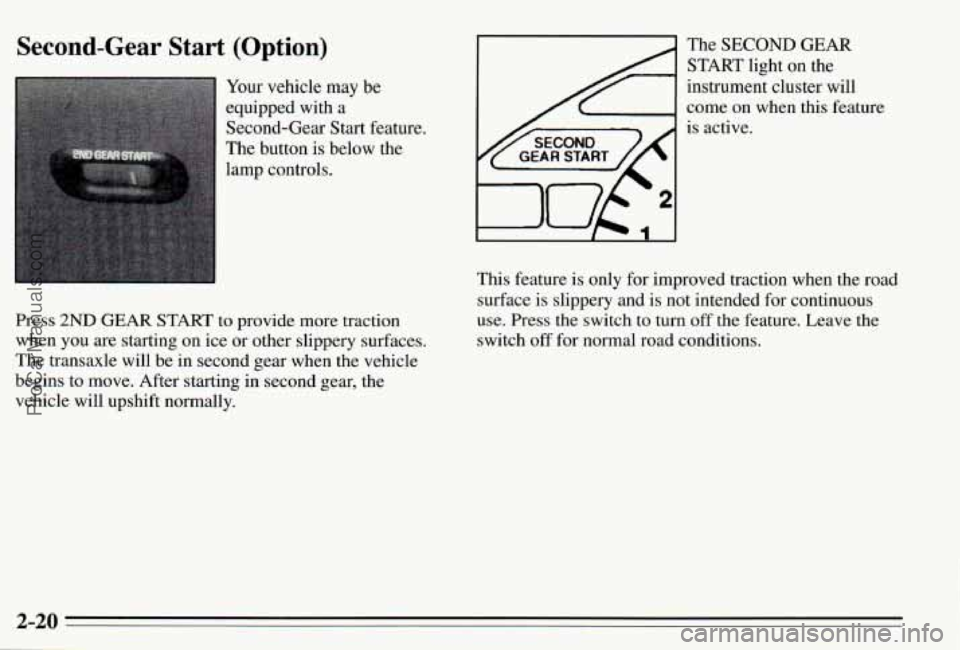
Second-Gear Start (Option)
Your vehicle may be
equipped with a
Second-Gear Start feature.
The button is below the
lamp controls.
Press
2ND GEAR START to provide more traction
when you are starting
on ice or other slippery surfaces.
The transaxle
will be in second gear when the vehicle
begins
to move. After starting in second gear, the
vehicle will upshift normally. The
SECOND GEAR
START
light on the
instrument cluster will
come on when this feature
is active.
This feature is only for improved traction when the road
surface is slippery and is not intended for continuous
use. Press the switch
to turn off the feature. Leave the
switch off for normal road conditions.
2-20
ProCarManuals.com
Page 152 of 354
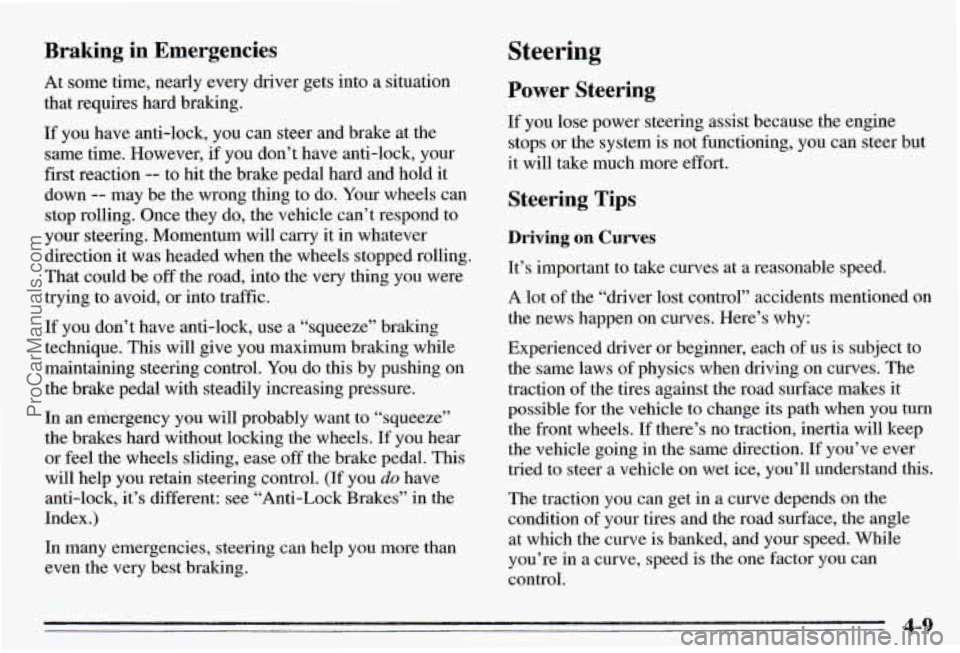
Braking in Emergencies
At some time, nearly every driver gets into a situation
that requires hard braking.
If you have anti-lock, you can steer and brake at the
same time. However,
if you don’t have anti-lock, your
first reaction
-- to hit the brake pedal hard and hold it
down
-- may be the wrong thing to do. Your wheels can
stop rolling. Once they do, the vehicle can’t respond to
your steering. Momentum will carry it in whatever
direction it was headed when the wheels stopped rolling.
That could be off the road, into the very thing you were
trying to avoid, or into traffic.
If you don’t have anti-lock, use a “squeeze” braking
technique. This will give you maximum braking while
maintaining steering control. You do this by pushing on
the brake pedal with steadily increasing pressure.
In an emergency you will probably want to “squeeze”
the brakes hard without locking the wheels. If you hear
or feel the wheels sliding, ease off the brake pedal. This
will help you retain steering control.
(If you do have
anti-lock, it’s different: see “Anti-Lock Brakes’’ in the
Index.)
In many emergencies, steering can help you more than
even the very best braking.
Steering
Power Steering
If you lose power steering assist because the engine
stops or the system is not functioning, you can steer but
it will take much more effort.
Steering Tips
Driving on Curves
It’s important to take curves at a reasonable speed.
A lot of the “driver lost control” accidents mentioned on
the news happen on curves. Here’s why:
Experienced driver or beginner, each of us is subject to
the same laws of physics when driving on curves. The
traction of the tires against the road surface makes it
possible for the vehicle to change its path when you turn
the front wheels. If there’s no traction, inertia will keep
the vehicle going in the same direction. If you’ve ever
tried to steer a vehicle on
wet ice, you’ll understand this.
The traction you can get in a curve depends on the
condition of your tires and the road surface, the angle
at which the curve is banked, and your speed. While
you’re in a curve, speed is the one factor you can
control.
4-9
ProCarManuals.com
Page 157 of 354
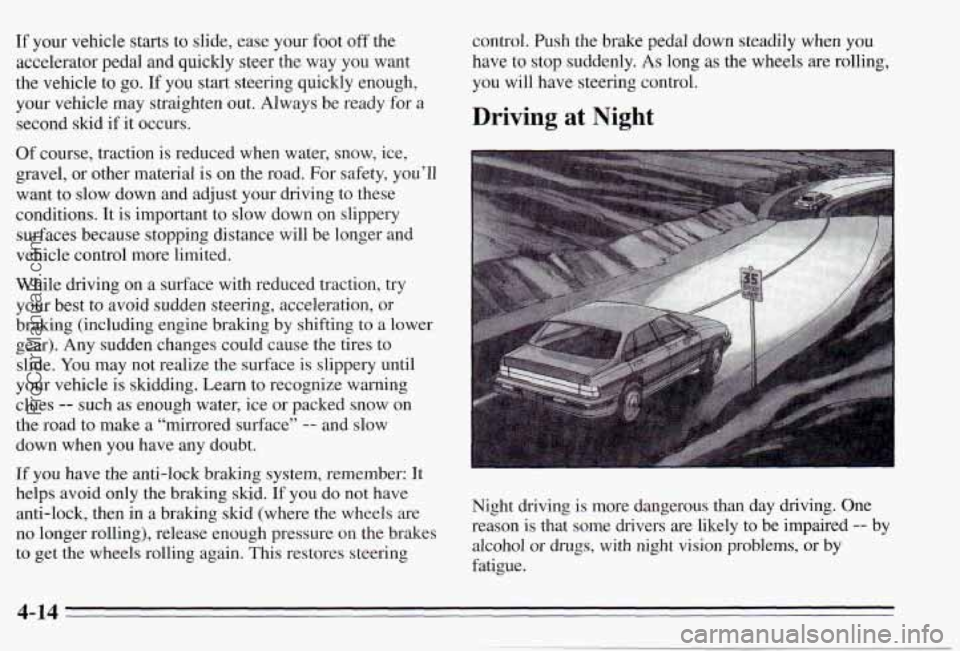
If your vehicle starts to slide, ease your foot off the
accelerator pedal and quickly steer the way you want
the vehicle to go.
If you start steering quickly enough,
your vehicle may straighten out. Always be ready for a
second skid if it occurs. control. Push the brake pedal down steadily when you
have
to stop suddenly.
As long as the wheels are rolling,
you will have steering control.
Driving at Night
Of course, traction is reduced when water, snow, ice,
gravel, or other material
is on the road. For safety, you’ll
want to slow down and adjust your driving to these
conditions. It is important
to slow down on slippery
surfaces because stopping distance will be longer and
vehicle control more limited.
While driving on a surface with reduced traction, try your best
to avoid sudden steering, acceleration, or
braking (including engine braking by shifting to
a lower
gear). Any sudden changes could cause the tires to
slide. You may not realize the surface is slippery until
your vehicle
is skidding. Learn to recognize warning
clues
-- such as enough water, ice or packed snow on
the road to
make a “mirrored surface” -- and slow
down when you have any doubt.
Lf you have the anti-lock braking system, remember: It
helps avoid only the braking skid. If you do not have
anti-lock, then in a braking
skid (where the wheels are
no longer rolling), release enough pressure on the brakes
to get the wheels rolling again. This restores steering Night driving is more dangerous than day driving. One
reason is that some drivers
are likely to be impaired -- by
alcohol or drugs, with night vision problems, or by
fatigue.
4-14
ProCarManuals.com
Page 264 of 354
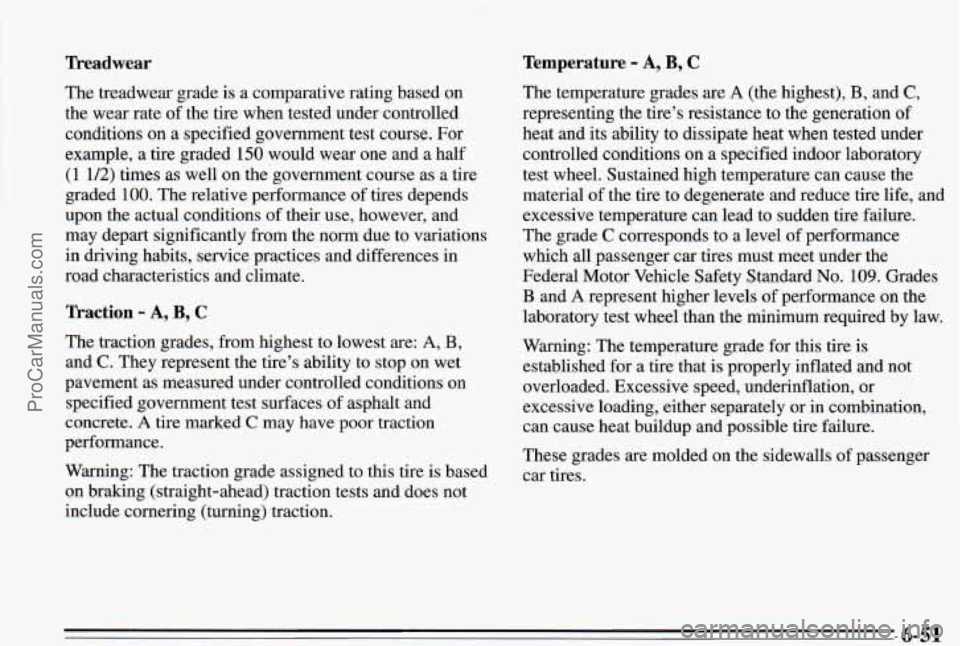
Treadwear Temperature - A, B, C
The treadwear grade is a comparative rating based on
the wear rate of the tire when tested under controlled
conditions on a specified government test course. For
example, a tire graded
150 would wear one and a half
(1 1/2) times as well on the government course as a tire
graded
100. The relative performance of tires depends
upon the actual conditions of their use, however, and
may depart significantly from the norm due to variations
in driving habits, service practices and differences in
road characteristics and climate.
Traction - A, B, C
The traction grades, from highest to lowest are: A, B,
and C. They represent the tire’s ability to stop on wet
pavement as measured under controlled conltions on
specified government test surfaces of asphalt and
concrete.
A tire marked C may have poor traction
performance.
Warning: The traction grade assigned to
this tire is based
on braking (straight-ahead) traction tests and does not
include cornering (turning) traction. The temperature grades are
A (the highest), B, and C,
representing the
tire’s resistance to the generation of
heat and its ability to dissipate heat when tested under
controlled conditions on a specified indoor laboratory
test wheel. Sustained high temperature can cause the
material of the tire to degenerate and reduce tire life, and
excessive temperature can lead to sudden tire failure.
The grade
C corresponds to a level of performance
which
all passenger car tires must meet under the
Federal Motor Vehicle Safety Standard
No. 109. Grades
B and A represent higher levels of performance on the
laboratory test wheel than the minimum required by law.
Warning: The temperature grade for this tire
is
established for a tire that is properly inflated and not
overloaded. Excessive speed, underinflation, or
excessive loading, either separately or
in combination,
can cause heat buildup and possible tire failure.
These grades are molded on the sidewalls of passenger
car tires.
ProCarManuals.com
Page 351 of 354
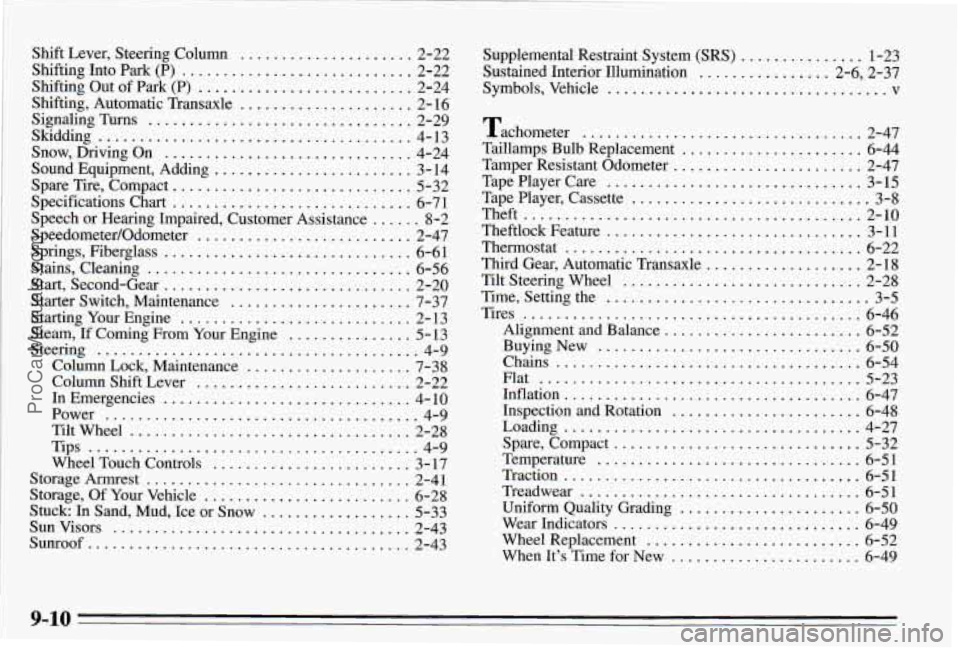
Shift Lever. Steering Column ..................... 2-22
Shifting
Into Park (P) ............................ 2-22
Shifting Out
of Park (P) .......................... 2-24
Shifting. Automatic Transaxle
..................... 2- 16
Snow, Driving On
.............................. 4-24
Sound Equipment, Adding
........................ 3-14
Spare Tire, Compact
............................. 5-32
Specifications Chart
............................. 6-7 1
Speedometer/Odometer .......................... 2-47
Springs, Fiberglass
.............................. 6-61
Stains, Cleaning
................................ 6-56
Start, Second-Gear .............................. 2-20
Starter Switch, Maintenance
...................... 7-37
Starting Your Engine
............................ 2- 13
Steam,
If Coming From Your Engine ............... 5-13
Steering
....................................... 4-9
Column Lock, Maintenance
.................... 7-38
Column Shift Lever
.......................... 2-22
InEmergencies
.............................. 4-10
Power
...................................... 4-9
Tiltwheel
.................................. 2-28
Tips
........................................ 4-9
Wheel Touch Controls
........................ 3-17
Storage Armrest
................................ 2-41
Storage, Of Your Vehicle ......................... 6-28
Stuck:
IR Sand, Mud, Ice or Snow .................. 5-33
Sunvisors
.................................... 2-43
Sunroof
....................................... 2-43
SignaLingTurns
................................ 2-29
Skidding
..................... ................ 4- 13
Speech or Hearing Impaired, Customer Assistance ...... 8-2 Supplemental Restraint System
(SRS) ............... 1-23
Sustained Interior Illumination
................ 2.6. 2.37
Symbols. Vehicle
.................................. v
Tachometer .................................. 2-47
Taillamps Bulb Replacement
...................... 6-44
Tamper Resistant Odometer ....................... 2-47
Tape Player Care
............................... 3-15
Tape Player. Cassette
............................. 3-8
Theft
......................................... 2-10
Theftlock Feature
............................... 3-11
Thermostat
.................................... 6-22
Third Gear. Automatic Transaxle
................... 2-18
Tilt Steering Wheel
.............................. 2-28
Time. Setting the
................................ 3-5
Tires
......................................... 6-46
Alignment and Balance
........................ 6-52
Buying New
................................ 6-50
Chains ..................................... 6-54
Flat
....................................... 5-23
Inflation
..................................... 6-47
Inspection and Rotation
....................... 6-48
Loading
.................................... 4-27
Spare, Compact
.............................. 5-32
Temperature
................................ 6-51
Traction
.................................... 6-51
Treadwear
.................................. 6-51
Uniform Quality Grading
...................... 6-50
Wear Indicators
.............................. 6-49
Wheel Replacement
.......................... 6-52
When It’s Time for New
....................... 6-49
9-10
ProCarManuals.com